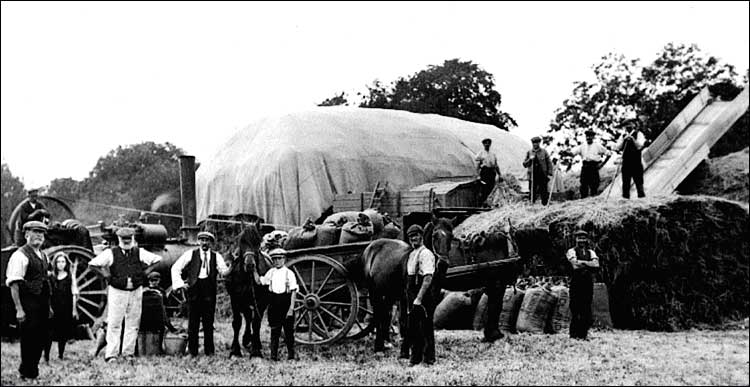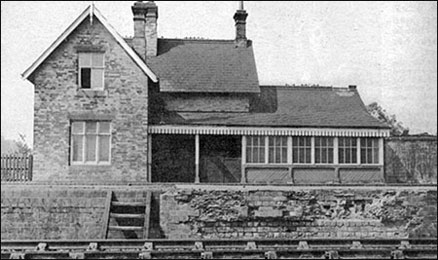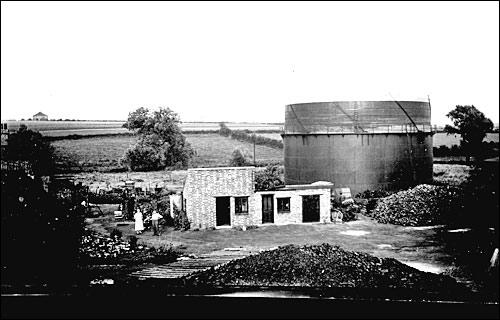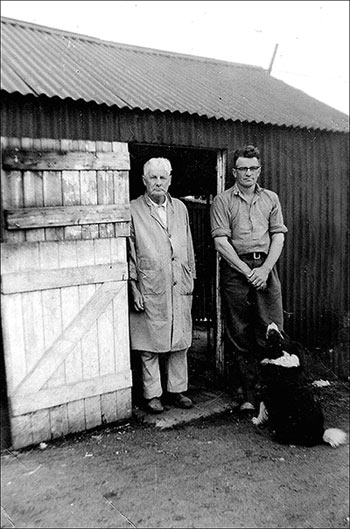| Taken from a book “Our Village Lives” written by Sally Szymanski with Madge Murdin presented by Margaret Jones (Craddock) | ||||||
|
||||||
|
||||||
| As a girl, Sally Szymanski who lives at Little Harrowden, used to visit Bungalow Farm where her mother’s maiden aunt, known as Auntie Madge, her mother’s sister, had been housekeeper for some years, for John Plowright – known by his second name George. George was a tenant of the farm, which was owned by a Mr John Abbott. George was a widower, with one son Geoffrey, who helped him on the farm. They had been there since the 1930s and George was a dairyman in Burton Latimer delivering milk every morning from their small herd of dairy cows. It was a mixed farm with cows, pigs, poultry and fields of arable crops such as swedes and mangolds for winter fodder. SALLY'S WEEKLY VISITS Every Thursday, Sally and her mother would catch the bus from their home, Little Harrowden, and walk down the hill from the Isham bus stop to the farm. Sally would then remain at the farm for the next two days, Thursday and Friday, before returning home on the Saturday. When they walked down to the farm from the bus stop, they used a pathway on the right hand side of the road. About halfway down on the left hand side there was a scrap yard, complete with all kinds of old vehicles and caravans for gipsies to live in. Below the yard was the old station complete with station house. The station was closed in the 1950s but Sally would enjoy watching the trains, both passenger and goods, that hurtled beneath the railway bridge.
Traffic lights had not been introduced to the bridge at this time and, with little traffic, it was possible to cross the bridge with care. On the right after the bridge, beyond the railway lines and bordering the River Ise, the busy site of Burton Latimer Gas Works could be seen. It contained two large gasometers and a boiler house together with a cottage for the Works Manager. Members the Boxwell family lived there at that time.
WEETABIX Crossing over the River Ise that ran below the railway line, there were the buildings of Weetabix, owned at that time by the George family. Sally would watch from the bridge over the river as the big cement pipe constantly pumped waste-water back into the river. Even then the Weetabix factory was a big concern and employed many local people from Burton Latimer and surrounding towns and villages. The firm sent buses out to pick up people for their shifts and several people worked there from Sally’s village, Little Harrowden,. THE BUNGALOW AND FARM Finally, Bungalow Farm appeared on the right. Access was by a wooden gate that led through a pretty flower garden to the porch, which was the entrance to the bungalow. The rest of the garden was planted with vegetables and fruit and from the rear there was another wooden gate led to the farmyard proper. The bungalow had had an extension built on at one time with a roof of corrugated iron that housed bedrooms and a bathroom. The porch led into the room that served as the kitchen, with one of those all-purpose kitchen units in it, with a drop down shelf at the front. The living room was beyond this with a bay window that looked out over the fields towards the river and railway line. Sally’s Auntie Madge had a small dairy attached to the kitchen where she made butter and cheese. The butter she made was very rich and Sally found it difficult to digest. Sally can remember playing darts with the farmhands who came into the bungalow for breakfast and also her Auntie’s delicious fried bread. After breakfast, together with Sally standing on a kitchen chair, everyone would have a game of darts using the dartboard that hung in the kitchen. The farmyard had pigsties in it, also milking sheds and accommodation for the herd of dairy cows in the winter. There was also a big haystack there and also a barn storing sacks of cow cake and farming implements. Cats abounded here, drawn by the rats and mice that were attracted by the food and grain stored in the barn. Geese at the top of the yard acted as good watchdogs. Two dogs were kept at the farm a collie, Prince, a working farm dog, and Monty allowed into the house occasionally but he lived in a kennel outside.
Uncle George (as Sally called him) had his own bedroom and Sally shared a bed with her Auntie as, at the time, Geoff, George’s son was still at home. He eventually married a Land Army girl called Margaret who worked on the farm and they moved across the road to one of the semi-detached houses on the left of Station Road. A Land Army girl called Lil had worked for some years on the farm prior to Margaret’s arrival, but she left to marry Walter Close, a local man from Kettering. Walt drove a motorcycle and side car combination with Lil riding pillion or in the sidecar with one of their children. This was endlessly fascinating to Sally as a mode of travel as she had never seen such a thing before. When they roared up to the garden gate, they all ran out to welcome them. Their eldest son was Malcolm and Sally. They played together in the garden when he visited. FARMING LIFE Life on the farm was full of interest for a young child. Sally was allowed to help feed the calves and let them greedily suck her fingers as they tried to suckle. The cows would be brought in twice a day for milking and Sally’s mum remembers that she was permitted to try and milk them. Hand milking was still carried out at that time but this was not always a success as the cows often would not let their milk down when inexperienced people tried to milk them. However, when Geoff started to milk them then the milk would come at once as they were used to his touch. When Sally stayed at the farm the milking machines had replaced hand milking. Sally usually steered clear of the geese as they could be cantankerous but they were allowed in the barn on occasions and children could always play in the garden. Sally’s Auntie would take them for picnics in the surrounding meadows that bordered the Isebrook River. One place was delightful especially in the summer – a little waterfall on the river, which was quite shallow at this point and they were allowed to go in and paddle, along with other local children. After making lemonade from crystals purchased from Boots the Chemist, Auntie Madge would pack up some sandwiches in an old tin and they would set off, sometimes joined by Sally’s mother and her sister Carol when she was old enough to visit the farm. The summers always seemed to be a lot hotter then. Sometimes they would cross the river over a rickety plank bridge and climb some stone steps to the top of the railway footbridge. Trains were very frequent and they found it really exciting to wave madly to the train driver who would sound his horn. ROYAL TRAIN On one occasion Queen Elizabeth II was due to pass Burton Latimer aboard the royal train on her way to visiting the north of the country. Sally was tremendously excited at the prospect of seeing this train. Together with her Auntie, at twilight, they made their way to the field that bordered the river and the railway line to wave at the appointed time. Other people had the same idea and quite a crowd had gathered. They were all disappointed when the train swept past with its windows closely curtained – never a glimpse of the Queen to be seen! They all still waved! LIFE AT THE FARM Sally thinks that she was spoilt by her Auntie and by “uncle” George as she called him. They had a television, so she was allowed to stay up and watch “Take your Pick” with Michael Miles on Friday evenings, which they all enjoyed, together with the horse racing which was on in the daytime. Madge was a really good cook and made wonderful pastry, being renowned for her mince pies. Her lemon curd was delicious as well. She made the toast in front of the fire with a toasting fork and it tasted much nicer than toast made in a more ordinary way. Christmas was a joyful time. The bungalow as decorated with paper bells and streamers and there would be big tins of Quality Street and White Heather for any visitors. The first Christmas present, Sally can remember being given was a clockwork train complete with track and a tin tunnel. Sally loved that train and played with it continuously. She also had a book of the film of “Hans Christian Anderson” featuring Danny Kaye. Other presents over time were a swing in the garden and a very superior doll’s pram, the wheels of which eventually became a go-cart. This was a very happy time for Sally. Her Auntie Madge would take baby goslings into the house to show her. Madge also obtained an Atlas from someone who worked at Weetabix. This enabled Sally to learn the flags of the different countries printed in it. She can remember the workers pouring out of the factory at home time into the pouring rain, on their bicycles covered with yellow rain capes as protection from the weather. A mobile shop owned by a man called Andy used to visit regularly to the farm and Sally was allowed to buy sweets or chocolate from him. Sometimes they would walk up to Mr Miller’s shop in Station Road (now a barber’s shop) to purchase groceries or household sundries, passing the main farmyard gate on the way. CHANGES AT THE FARM When Sally was six or seven years old her “uncle” George was taken ill and died. She has vague memories of walking on the footpath up to Isham, with her Auntie Madge. The village was about half a mile away from the farm. They were going to see the undertaker, Rex Buswell, who lived in a white cottage on the edge of Isham village, to see about funeral arrangements. Sally was too young to attend the funeral but her mum went with Auntie Madge. As George was only the tenant of the farm, Auntie Madge had to leave and Geoff and his wife Margaret sold their house in Station Road and went to live in Kettering. The farm was let to someone else and Auntie Madge went back to live at Hilllside cottages which stood back from the main Kettering to Wellingborough road. The bungalow, which gave the farm its name, stands to this day, greatly altered, but the farm was eventually sold off for building land and houses stand where the farmyard used to be. An electricity sub-station was erected just below the bungalow. The meadow bordering the river is now a pocket park where people can still walk and sit by the little waterfall on the river. Sally and her family no longer live in Little Harrowden but she still visits the village regularly. |
||||||



